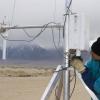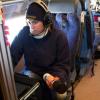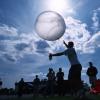In-Situ Sensing Facility (ISF)
Mission
EOL's In-Situ Sensing Facility (ISF) plays a crucial role in meeting the advanced observational needs of the atmospheric science community. The Facility offers a highly-adaptable, state-of-the-art backbone measurement capability that caters to a wide range of experimental needs - placing a strong emphasis on advanced sensor capabilities, seamless sensor integration, system mobility, and the capability to operate in remote and challenging environments.
We specialize in providing both in-situ and remote measurement systems designed for observations that target the lower atmosphere. Our data collection efforts encompass direct in-situ measurements taken at the Earth's surface, on towers, on balloons and on packages dropped from research aircraft. Additionally, we conduct remote profiling measurements using vertically pointing radar, lidar, and acoustic sensors.
ISF is organized into three distinct groups - the Surface Group, the Sounding Group and the Atmospheric Profiling Group:
Surface Group
 The Surface Group specializes in the development and deployment of systems designed for measuring critical aspects of the Earth's surface layer, including the surface energy budget and various surface properties. This group deploys the Integrated Surface Flux System (ISFS) and operates the EOL Calibration Laboratory.
The Surface Group specializes in the development and deployment of systems designed for measuring critical aspects of the Earth's surface layer, including the surface energy budget and various surface properties. This group deploys the Integrated Surface Flux System (ISFS) and operates the EOL Calibration Laboratory.
Sounding Group
 The Sounding Group specializes in the development of sensors that are dropped from aircraft and balloons, along with the associated data systems. This group is responsible for the deployment of the AVAPS Dropsonde System on various research aircraft, including those operated by NCAR. Additionally, the group has also designed and deployed the Driftsonde system, which is utilized for high-latitude, long-duration balloon-based observations.
The Sounding Group specializes in the development of sensors that are dropped from aircraft and balloons, along with the associated data systems. This group is responsible for the deployment of the AVAPS Dropsonde System on various research aircraft, including those operated by NCAR. Additionally, the group has also designed and deployed the Driftsonde system, which is utilized for high-latitude, long-duration balloon-based observations.
Atmospheric Profiling Group
 The Atmospheric Profiling Group specializes in the development and operation of instruments dedicated to profiling the Earth's atmosphere. Their focus encompasses a range of atmospheric observations, with an emphasis on radar wind profilers, radiosonde soundings, and fundamental surface measurements. To facilitate observations, the group maintains and deploys the Integrated Sounding System (ISS).
The Atmospheric Profiling Group specializes in the development and operation of instruments dedicated to profiling the Earth's atmosphere. Their focus encompasses a range of atmospheric observations, with an emphasis on radar wind profilers, radiosonde soundings, and fundamental surface measurements. To facilitate observations, the group maintains and deploys the Integrated Sounding System (ISS).

